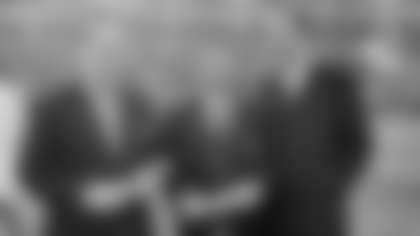"Inside the Stacks: Exploring important documents in Chiefs history" is a series of columns based on never-before-seen documents and correspondence from the Lamar Hunt archives, including many from the founding and early days of the American Football League, the merger with the National Football League, and other historic moments up until the time of Hunt's death.
For Part One of this series, click here.
Most of the handwritten notes that Lamar Hunt took from his early AFL-NFL merger meetings with Tex Schramm dealt with the New York and San Francisco questions.
How could two franchises in both metro areas exist in the same marketplace?
"Some of the things relative to New York and Oakland were difficult," Hunt recalled, "and that's where we had our biggest problems."
Indeed, in the early going of the talks, Schramm had limited his contacts to the clandestine meetings with Hunt to the New York and San Francisco owners, and to NFL commissioner Pete Rozelle. Hunt limited his to Buffalo's Ralph Wilson and Boston's William Sullivan.
The NFL owners expressed reservations about two teams existing in New York and San Francisco, but agreed that Schramm should proceed.
The talks continued, and eventually all owners in both leagues were brought up to speed on what was on the table, and the negotiations continued. The 49ers were generally on board, but the Giants were hard to convince.

Competing with the suddenly glamorous Jets, who were a far cry from the dysfunctional Titans – the former name of the Jets franchise – was beginning to become quite a task, so the two sides came to the agreement that the Giants, regardless of their record, would get the first pick only for the 1967 NFL Draft. But they had to draft a quarterback, or they could trade the pick only for a quarterback, which they eventually did in acquiring Fran Tarkenton from Minnesota.
Points on how the four franchises in New York and San Francisco-Oakland would co-exist dominate much of the final agreement the two leagues signed:
1. In New York and San Francisco-Oakland, if one team is home and the other on the road, the home team may telecast by either TV or pay TV.
2. Prior to 1970, either the Raiders or 49ers may play on the other's side of the bay. After that date, neither may play on the other's side of the bay without the other's consent.
3. The 49ers will never play more than one-half of their regular season games out of San Francisco.
4. The 49ers and Raiders will not play at night at home without each other's consent.
5. The Giants are granted the right to use Shea Stadium on the same terms as the Jets. The Jets retain the same for Yankee Stadium.
6. The Giants request a minimum of five dates between the start of the regular season and December 1 of each year.
7. The Giants and Jets will not play night home games without each other's consent.
8. All road games of the Giants and Jets will be telecast back to the New York area.
9. The Raiders and 49ers will play one preseason game every year.
10. Every effort must be made so that the Giants and Jets in New York and the Raiders and 49ers in the Bay Area will not conflict on TV.
11. In the Bay Area, if one team is home, the other's road game will be televised back home.
12. In the Bay Area, all road games for both teams will be televised back to the Bay Area.
13. In the Bay Area, there can be no direct home schedule conflict until it is mutually agreed upon by both. Neither will play at night without the other's consent.
14. The 49ers and Raiders must get approval from each other for preseason game contracts with other opponents.
How important was solving the New York-San Francisco issue?
The final agreement dated June 8, 1966, stated it as point 1:
"All existing franchises would remain in the same cities."
And so it was to remain until the Raiders moved from Oakland to Los Angeles in 1982, returned to Oakland in 1995, and then settled in Las Vegas in 2020.
SOURCES: "AFL-NFL Merger Negotiations," Cabinet 16, Drawer D. "AFL-NFL Merger 1966," Cabinet 16, Drawer E. "Joint Statement, National and American Football League," June 6,1966. Lamar Hunt to Hamilton Carothers, June 14, 1966. Lamar Hunt to Clark Breeding, August 9, 1966. "The Men Behind the Merger," Tim Cowlishaw, Dallas Morning News, June 11, 1986. Lamar Hunt to Jim Perry, November 15, 1990. "Peacemakers," Jim Perry, Super Bowl XXV Program, January, 1991.













